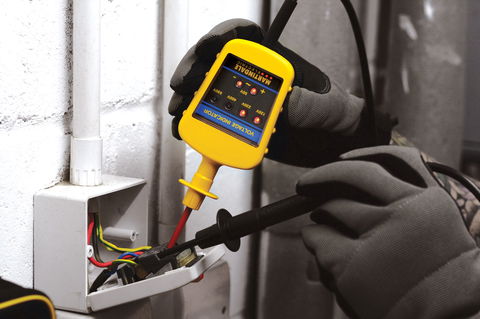With electricity cited as the root cause of about 1,000 accidents at work each year developing safe isolation processes that safeguard people has never been more important. Voltage indicators should already be an integral part of your electrical safety processes. They do exactly what they say: they indicate the presence of voltage.

The best voltage indicators for safe isolation should be made to BS EN 61243-3 for full compliance with the current GS38 standard. They should be engineered with safety in mind, eliminating batteries and switches that could lead to false indications and come with bright, clear displays for voltage reading, such as the Martindale Electric VI13800 and VI15000 voltage indicators. A durable design that can take some rough handling should also be a consideration.
However, even if you follow this advice and even bearing in mind that voltage indicators are designed with inherent reliability, can you 100% guarantee that your voltage indicator is working correctly every time? It only needs to fail once for the consequences to be potentially disastrous; never forget that 16% of deaths in the workplace are linked to electricity.
For maximum safety, it is vital to verify the performance of your voltage indicator. It’s as important as confirming that the appliance or circuit being tested is dead, and that there is no possibility of it becoming live while you are working.
Before testing the circuit, voltage indicators should therefore be proved using a proving unit, then test the circuit, then test the voltage indicator against the unit once again to prove that the tester is still functioning properly. The device will verify the performance of the voltage indicator.
If you use a battery powered voltage indicator then proving the unit is working and the battery is not flat, couldn’t be more important. Furthermore, a lack of positive indication does not always prove absence, which is why the cross-check with a proving device could quite literally be a lifesaver.
Prove it
Essentially a proving unit is a portable device that serves as a voltage source designed specifically to verify that voltage indicators are working correctly. Some people still rely on testing electrical test tools, such as voltage indicators, against a live source, but this is not always a safe or convenient option. A proving device has been designed to provide a live source wherever you are working - with no need to leave the working area – and is considerably safer.
Proving units are very quick and easy to use. In the case of the Martindale PD440-S 440V AC proving device, for example, you simply place one probe of the voltage indicator under test into the left hand socket of the proving unit until it makes contact with the terminal. Then place the other probe into the right hand terminal of the proving unit and gently press down. This will result in the high voltage indicator illuminating to show the unit under test is functioning correctly.
As an added tip, during testing of your voltage indicator, it is recommended to flex the voltage indicator cable along its length - particularly at the entry points to the handheld elements - to confirm that the cable has not fractured
It is advisable to use a dedicated proving unit matched to the voltage indicator in order to fully test that all LEDs on all ranges of the voltage indicator are working - safeguarding against incorrect readings due to a faulty LED, for example. Furthermore, it is important not to over-prove: a three-phase voltage indicator should be proved at 440V whereas a common 2 pole indicator with a 690V range should be proved at 690V.
Martindale Electric recently launched its ALIVE campaign, which outlines 5 simple steps for staying alive when working around electricity. Downloadable resources for heating and plumbing installers are available on the campaign page at the company’s website:
